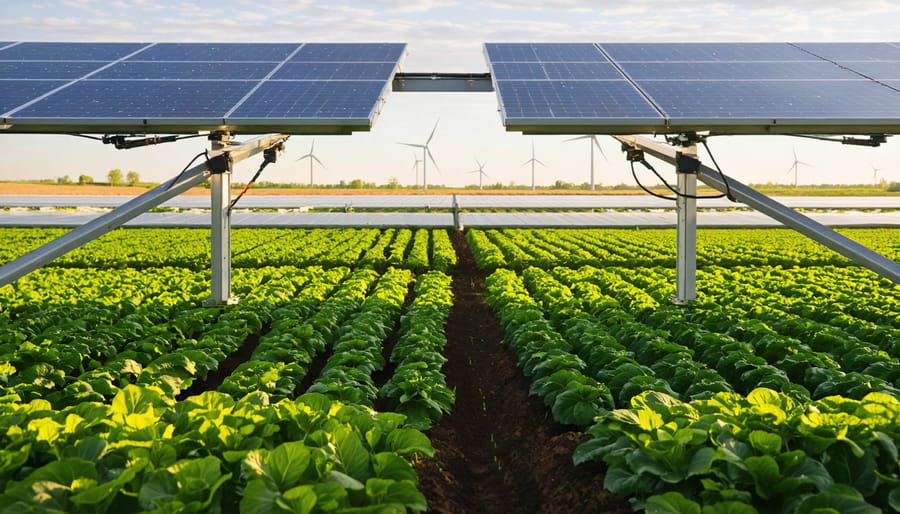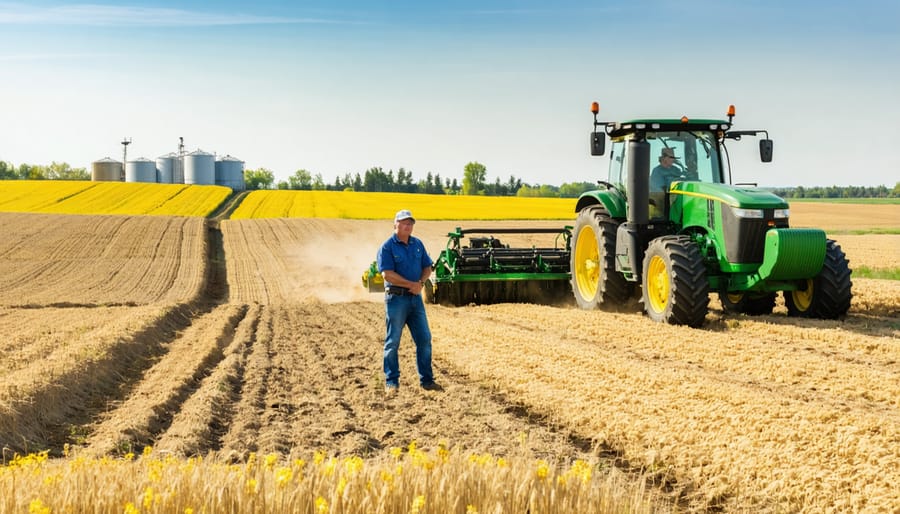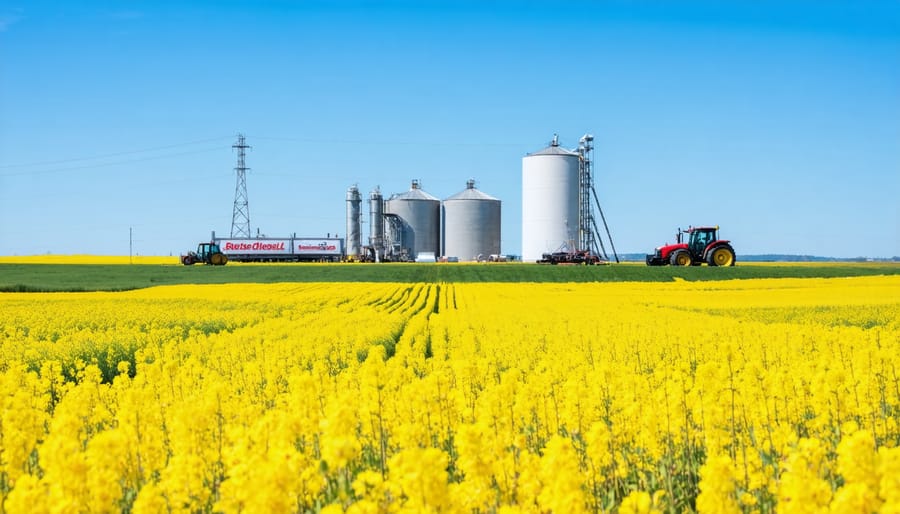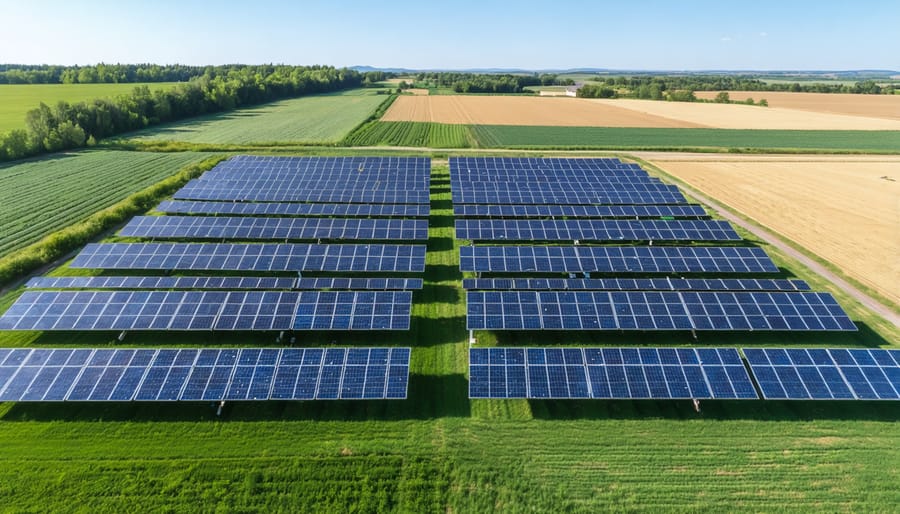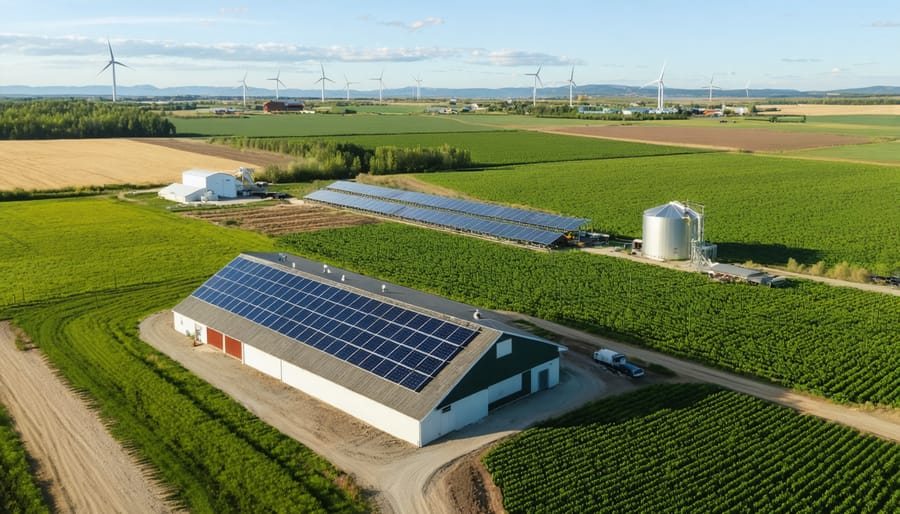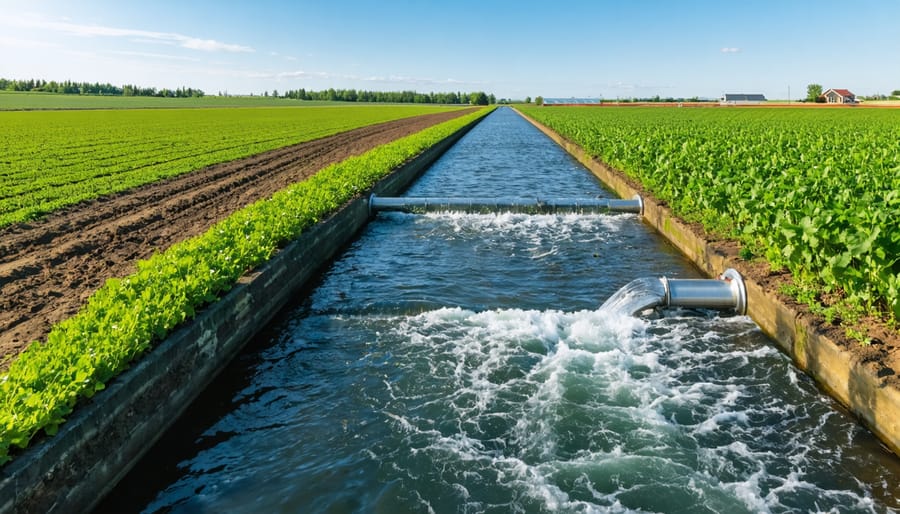Transform your farm’s energy independence by combining proven storage technologies with renewable power generation. Battery systems paired with solar arrays now offer Canadian farmers up to 12 hours of reliable backup power, while advanced thermal storage solutions maintain consistent temperatures in agricultural facilities for up to 72 hours. As more Alberta farmers invest in solar power, integrating smart energy management systems has reduced operational costs by an average of 40% across monitored properties.
Modern agricultural operations can’t afford disruptions in power supply. Whether protecting sensitive hydroponics systems or maintaining critical livestock environmental controls, today’s storage solutions provide the reliability needed for year-round farming. From flow batteries that function in -40°C conditions to hydrogen fuel cells that offer weeks of backup power, Canadian farmers now have access to storage technologies specifically engineered for our challenging climate.
The future of farming demands energy independence, and storage solutions are the missing piece that makes 24/7 renewable power possible. With federal grants covering up to 50% of installation costs, there’s never been a better time to upgrade your farm’s energy infrastructure.
Battery Solutions That Work in Alberta’s Climate
Advanced Lithium Systems for Farm Operations
Modern lithium battery systems have become a game-changer for Canadian farmers looking to maximize their solar-powered farm operations. These advanced storage solutions offer unprecedented flexibility and reliability, particularly during Alberta’s varied seasonal conditions.
Today’s lithium systems feature improved cold-weather performance, with many units maintaining efficiency at temperatures as low as -30°C. This makes them ideal for year-round operation in our prairie climate. Most modern units come with smart monitoring capabilities, allowing farmers to track energy usage and storage levels through smartphone apps.
A standard 13.5 kWh lithium battery system can power essential farm equipment, including irrigation systems and barn ventilation, for 12-16 hours during peak demand. Multiple units can be connected in parallel to increase capacity based on specific farm needs.
The latest generation of lithium batteries offers an operational lifespan of 10-15 years, with minimal maintenance requirements. Many Alberta farmers report that these systems pay for themselves within 5-7 years through reduced energy costs and improved operational reliability.
Local success stories include the Davidson family farm near Red Deer, which uses a 40 kWh system to power their entire dairy operation, including milking equipment and cold storage. They’ve maintained consistent operations even during grid outages, demonstrating the reliability of modern lithium storage solutions.

Cold-Weather Performance Solutions
Here in Alberta, maintaining battery efficiency during our harsh winters is crucial for reliable renewable energy storage. Through our work with local farmers, we’ve identified several proven solutions that keep your systems running smoothly, even when temperatures plummet below -30°C.
Insulated battery housings are your first line of defense. Many farmers in the Peace Country region have found success using double-walled enclosures filled with mineral wool insulation, which maintains optimal battery temperatures while being fire-resistant. These housings can be built using locally available materials and are relatively inexpensive to construct.
Temperature-regulated battery rooms have become increasingly popular, especially for larger operations. These dedicated spaces use passive solar heating and thermal mass principles to maintain consistent temperatures. Jim Anderson, a dairy farmer near Red Deer, reports that his temperature-regulated system has maintained 95% efficiency throughout winter months.
Battery heating systems, either built-in or retrofitted, are another effective solution. Modern lithium-ion batteries often come with integrated heating elements that activate automatically when temperatures drop. For existing systems, adding thermal management technology can extend battery life and maintain performance.
Regular maintenance becomes even more critical during winter. Check your insulation integrity monthly, ensure ventilation systems are working properly, and monitor battery temperature readings daily. Many successful operations combine these approaches for maximum reliability.
Thermal Storage: Converting Excess Energy to Heat

Greenhouse Heat Banking Systems
Modern greenhouse operations are discovering innovative ways to maximize their greenhouse energy solutions through heat banking systems. These systems capture excess solar energy during peak daylight hours and store it for use during colder periods, significantly reducing heating costs and enhancing year-round growing capabilities.
In Alberta, farmers are implementing thermal mass storage using water tanks and stone beds beneath their greenhouses. These materials absorb heat during the day and slowly release it at night, maintaining stable temperatures for crops. A typical 1,000-square-metre greenhouse can benefit from a 20,000-litre water thermal storage system, potentially reducing heating costs by 30-40% during winter months.
Local success stories include the Sunnyside Greenhouse operation near Lethbridge, where owner Sarah Thompson installed a heat banking system using recycled concrete blocks and water storage. “We’ve extended our growing season by six weeks and cut our natural gas consumption in half,” Thompson reports.
Phase change materials (PCMs) are emerging as another effective storage solution. These substances absorb and release heat at specific temperatures, providing more consistent temperature control. While the initial investment ranges from $15,000 to $30,000 for a medium-sized greenhouse, many farmers report complete payback within 3-5 years through reduced heating costs.
For best results, combine these systems with proper insulation and automated climate control systems. The Alberta Agricultural Energy Savings Program offers grants covering up to 50% of installation costs for qualified projects.
Water-Based Thermal Storage
Water-based thermal storage systems are proving to be a game-changer for Alberta farmers looking to manage energy costs and reduce their environmental footprint. These systems work by storing excess heat in large, insulated water tanks during peak production periods and releasing it when needed, making them particularly valuable during our harsh prairie winters.
Several Alberta dairy farmers have successfully implemented these systems, using them to maintain consistent barn temperatures and heat water for cleaning equipment. For example, the Henderson family farm near Red Deer paired their solar panels with a 5,000-litre thermal storage tank, cutting their heating costs by 40% in the first year.
The beauty of water-based storage lies in its simplicity and reliability. Water can hold a remarkable amount of heat energy – about 4.2 kJ per kilogram per degree Celsius. This means a medium-sized system can store enough energy to heat your barn or greenhouse through several cloudy days or overnight periods.
Installation costs typically range from $15,000 to $30,000, depending on system size. However, many farmers report payback periods of 4-6 years through reduced energy bills. The Canadian Agricultural Partnership currently offers grants covering up to 30% of installation costs for approved thermal storage projects.
For best results, consider integrating these systems with existing renewable energy setups and insulating storage tanks properly to minimize heat loss.
Real Alberta Success Stories
Davidson Family Farm’s Solar Battery System
Located just outside of Olds, Alberta, the Davidson Family Farm has transformed their 800-hectare operation through the implementation of a comprehensive solar battery system. In 2021, John and Sarah Davidson made the strategic decision to invest in a 75kW solar array coupled with a 100kWh battery storage system to power their grain drying operations and workshop facilities.
“We used to rely heavily on diesel generators during peak seasons,” explains John Davidson. “The combination of rising fuel costs and our commitment to sustainable farming pushed us to explore renewable alternatives.”
The system, which includes 250 solar panels and two commercial-grade lithium iron phosphate batteries, was installed with support from Alberta’s On-Farm Energy Management Program. The Davidsons received a 50% cost-share grant, significantly reducing their initial investment of $175,000.
The results have exceeded expectations. During the first year of operation, the farm reduced its diesel consumption by 70% and achieved complete energy independence during crucial harvest periods. The battery system provides reliable power for up to 72 hours during cloudy periods, ensuring continuous operation of essential equipment.
“What surprised us most was the system’s performance during winter,” Sarah Davidson notes. “Even with shorter days, we maintain about 60% of our summer energy production, which is more than adequate for our off-season needs.”
The success has inspired neighbouring farms to explore similar solutions, with the Davidsons regularly hosting educational tours for local agricultural groups. They emphasize the importance of proper sizing and professional installation, recommending thorough energy audits before making the investment.
Red Deer Valley Greenhouse Operation
The Red Deer Valley Greenhouse operation, located just outside of Drumheller, Alberta, showcases how thermal energy storage can revolutionize year-round growing operations in Canada’s harsh climate. In 2021, owner Sarah Thompson implemented a innovative thermal storage system that’s helping her maintain consistent temperatures while reducing energy costs by 40%.
The system uses a combination of underground thermal mass storage and phase-change materials to capture excess heat during sunny days and release it during cold nights. Two large underground chambers, filled with locally sourced river rock, store heat generated from solar collectors mounted on the greenhouse roof. This stored energy maintains optimal growing temperatures even when outside temperatures drop to -30°C.
“Before installing the system, our heating bills were astronomical,” Thompson explains. “Now we’re seeing significant savings, and our crops are thriving with more consistent temperatures.” The greenhouse successfully produces tomatoes, cucumbers, and leafy greens year-round, serving local markets within a 100-kilometer radius.
The project received partial funding through Alberta’s Agricultural Partnership Program, covering 30% of the $175,000 installation costs. Thompson expects to recoup the remaining investment within five years through reduced energy costs and extended growing seasons.
What makes this case particularly noteworthy is its scalability. The system’s modular design allows for expansion as needed, and its performance in extreme weather conditions proves its viability for other Alberta greenhouse operations. Local agricultural extension officers regularly host tours of the facility, helping other farmers understand how similar systems could work for their operations.

Financial Support and Resources
Alberta farmers looking to invest in renewable energy storage solutions have access to numerous financial support programs and resources. The Canadian Agricultural Partnership (CAP) offers grants covering up to 50% of eligible costs for implementing sustainable farm solutions, including battery storage systems and smart grid technologies.
The Alberta Municipal Solar Program (AMSP) provides rebates of up to $0.75/watt for solar PV installations, which can be combined with storage solutions. Additionally, the Energy Efficiency Alberta initiative offers specialized funding for agricultural operations implementing comprehensive energy management systems.
Local agricultural cooperatives have established equipment-sharing programs, reducing initial investment costs for members. The Farm Credit Canada (FCC) Energy Loan program provides flexible financing options with competitive interest rates specifically for renewable energy projects, including storage components.
For smaller operations, the Alberta Farm Solar PV Program offers microgeneration credits and simplified application processes. Technical assistance grants are available through provincial extension services, covering consultation fees and feasibility studies.
Resources extend beyond direct funding. The Alberta Association of Municipal Districts and Counties (AAMDC) provides bulk purchasing programs, helping farmers secure better prices on energy storage equipment. Free energy assessment services are available through local agricultural societies, helping farmers identify the most cost-effective storage solutions for their operations.
To access these supports, connect with your local agricultural fieldman or visit the Alberta Agriculture and Forestry website. Regular workshops and information sessions are held throughout the province, offering guidance on application processes and project planning. Remember to maintain detailed records of your current energy usage and costs when applying for funding, as this information strengthens grant applications.
As we’ve explored throughout this article, renewable energy storage solutions offer practical and cost-effective ways for Alberta farmers to enhance their energy independence and sustainability. From battery systems to thermal storage, these technologies are becoming increasingly accessible and adaptable to our unique agricultural landscape.
Taking the first step toward implementing storage solutions doesn’t have to be overwhelming. Start by conducting an energy audit of your farm operations to understand your specific needs. Connect with local agricultural extension services and renewable energy consultants who can provide personalized guidance based on your farm’s requirements and budget.
Remember that financial support is available through various programs, including the Canadian Agricultural Partnership and Alberta’s Energy Savings for Business Program. These initiatives can significantly reduce your initial investment costs and improve your return on investment.
Consider joining local farmer networks and agricultural cooperatives that focus on sustainable practices. These communities offer valuable insights from peers who have already implemented storage solutions and can share their experiences and lessons learned.
For your next steps, we recommend:
– Reaching out to your local agricultural office for guidance
– Connecting with experienced farmers in your area
– Scheduling consultations with renewable energy providers
– Reviewing available grants and funding options
– Starting small and scaling up based on results
By taking these strategic steps and leveraging available resources, you can successfully integrate renewable energy storage into your farming operations, contributing to both environmental sustainability and your farm’s long-term prosperity.



